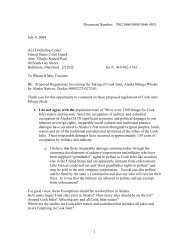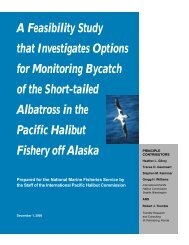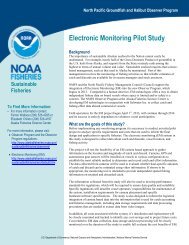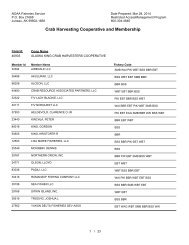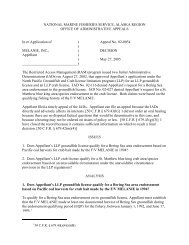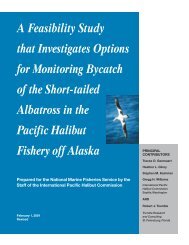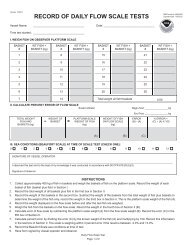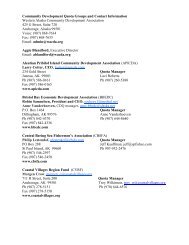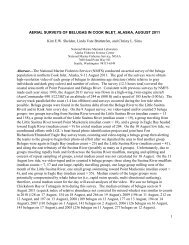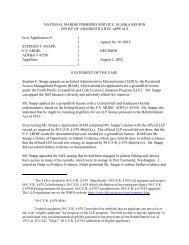Petition to List Lynn Canal Pacific Herring under the Endangered ...
Petition to List Lynn Canal Pacific Herring under the Endangered ...
Petition to List Lynn Canal Pacific Herring under the Endangered ...
You also want an ePaper? Increase the reach of your titles
YUMPU automatically turns print PDFs into web optimized ePapers that Google loves.
and Schweigert, 1991; Rooper, 1996). Preda<strong>to</strong>rs of herring spawn include birds,<br />
invertebrates, marine mammals, and fishes.<br />
While <strong>the</strong> rates of herring spawn consumption for <strong>the</strong> five avian preda<strong>to</strong>rs are<br />
approximations, our model suggests that <strong>the</strong>se preda<strong>to</strong>rs are a significant<br />
component in <strong>the</strong> loss of herring spawn.<br />
At <strong>the</strong> same time, <strong>the</strong> high consumption by gulls, shorebirds, and surf scoters<br />
<strong>under</strong>scores <strong>the</strong> importance of herring spawn in <strong>the</strong> annual cycle of <strong>the</strong>se species.<br />
<strong>Herring</strong> spawn contributes <strong>to</strong> meeting energy requirements for both breeding and<br />
migration.<br />
(Bishop and Green 2001). Sea lions congregate in Berners Bay <strong>to</strong> exploit <strong>the</strong> Eulachon<br />
spawning runs in April and Mayof each year (Sigler et al. 2004). Sea lions also take<br />
herring during this time and throughout <strong>the</strong> year. Finally, Humpback Whales also prey<br />
upon herring (NMFS 2005a). However, <strong>the</strong> <strong>to</strong>tal predation pressures exerted on herring<br />
is not a new phenomenon. Indeed, two major preda<strong>to</strong>rs, <strong>the</strong> Steller Sea Lion and<br />
Humpback Whale, are currently ESA-listed so <strong>the</strong> predation pressure on <strong>Lynn</strong> <strong>Canal</strong><br />
<strong>Herring</strong> is probably less now than it was before <strong>the</strong>se preda<strong>to</strong>rs were depleted. In<br />
conclusion, while predation is a constant fac<strong>to</strong>r in herring population dynamics, <strong>the</strong> cause<br />
of <strong>the</strong> observed population collapse is primarily a result of overfishing and <strong>the</strong><br />
destruction of spawning areas.<br />
E. O<strong>the</strong>r Natural and Manmade Fac<strong>to</strong>rs Affecting<br />
Continued Existence<br />
1. Changing Ocean Conditions<br />
The warming of <strong>the</strong> oceans in recent decades is well documented (Behrenfeld et<br />
al. 2006). This warming threatens <strong>to</strong> reduce <strong>the</strong> amount of phy<strong>to</strong>plank<strong>to</strong>n and<br />
zooplank<strong>to</strong>n throughout <strong>the</strong> oceans. <strong>Lynn</strong> <strong>Canal</strong> <strong>Herring</strong> feed directly on plank<strong>to</strong>n, so<br />
continued oceanic warming will reduce <strong>the</strong> available food. A recent article in <strong>the</strong> journal<br />
Nature analyzed <strong>the</strong> impact of warming ocean temperatures on phy<strong>to</strong>plank<strong>to</strong>n abundance<br />
(Behrenfeld et al. 2006).<br />
Climate effects on ocean biology are documented here for nearly a decade of<br />
satellite ocean colour measurements. It is also clear from <strong>the</strong> current analysis that<br />
surface warming in <strong>the</strong> permanently stratified ocean regions is accompanied by<br />
reductions in productivity. The index used here (MEI) <strong>to</strong> relate climate variability<br />
<strong>to</strong> [net primary productivity] NPP trends does not distinguish natural from<br />
anthropogenic contributions, but observational and modelling efforts indicate that<br />
recent changes in [sea-surface temperature] SST are strongly influenced by<br />
anthropogenic forcing. These observations imply that <strong>the</strong> potential transition <strong>to</strong><br />
permanent El Niño conditions in a warmer climate state would lead <strong>to</strong> lower and<br />
redistributed ocean carbon fixation relative <strong>to</strong> typical contemporary conditions.<br />
Such changes will inevitably alter <strong>the</strong> magnitude and distribution of global ocean<br />
56



